Project Log: Sunday, January 30, 2011
I removed the port engine room bulkhead and, down on the
bench, made the final cut along the newly-struck level
line that defined the final top edge. |
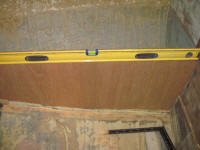
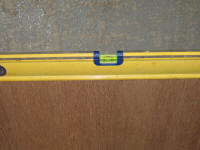 |
With the piece back in place, I tested the overall
height to ensure that the tanks would slip over the top
and into position as intended, first with the cardboard
mockups, and then with the actual fuel tank intended for
the space. |
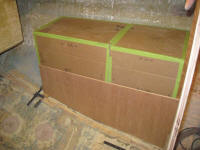
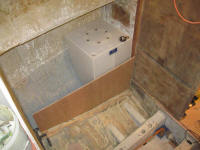 |
Because the pilothouse door was narrower than the tanks'
minimum dimension, I lowered the tanks into the boat
through the large overhead hatch, resting them
temporarily on a board that I placed across the
pilothouse windows; then, from inside, I could lift and
lower the tank the remainder of the way. The odd
shapes of the tanks made handling them awkward. |
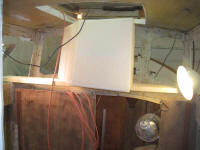 |
I was pleased to find that the actual tank fit nicely,
and fit over the bulkhead with no problem.
Obviously I would have been displeased had this not been
the case, since I'd designed and built everything
carefully around the tank designs, but despite knowing
that things should fit, there was always a certain
satisfaction to be had when they actually did.
This feeling never goes away. |
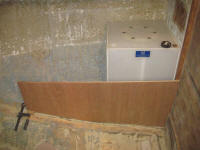 |
Having confirmed the height and location of the bulkhead
on the port side, I repeated the overall process on the
starboard side, beginning with a support cleat on the
existing bulkhead. |
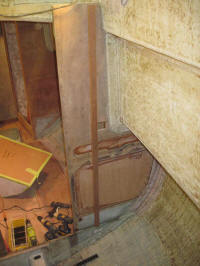 |
The port bulkhead was a close enough fit on the
starboard side that I could use it as a general template
for the rough-cut starboard blank, which, as before, I
temporarily clamped in place, aligned it perpendicular
with the transverse bulkhead, and scribed the lower edge
to match the shape of the hull. |
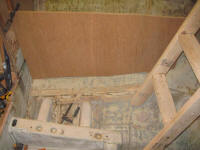 |
I made the final bottom cut, transferred the height of
the port bulkhead over to the starboard, made the level
top cut, and the starboard side was complete.
With the second side clamped in place, I test-fit the
starboard fuel tank behind it. Immediately, I
noticed that the tank had more room on this side. |
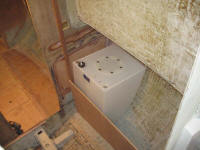 |
Asymmetry is common--no, universal--in boats, at least
boats on which I've ever worked, but somehow it seems to
rear its not-so-pretty head in unexpected places.
One takes pains to lay out new structures in careful and
measured ways, yet somewhere during the process some
oddball asymmetry or another is bound to turn up.
A couple quick measurements between the hull and the
bulkhead cleats confirmed what the tanks were telling
me: there was more room between the starboard
tankage bulkhead and the hull than there was on the port
side--about an inch. I further confirmed the
anomaly by measuring between each bulkhead and the edge
of the engine foundation.
I'd done all my initial tank measurements and mockups on
the port side only, and had never tested exactly how
they'd fit on the starboard side. I was glad it
turned out the starboard side had more room, not
less, as I'd not allowed for much clearance in my
design. |

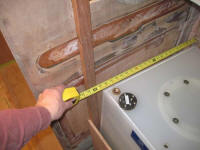
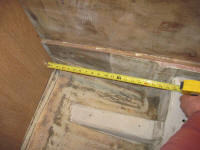
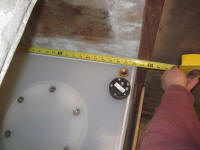 |
In my initial layout, some weeks ago, of the new tank
designs, I'd chosen a more-or-less arbitrary measurement
for where I thought the bulkheads should go, based on
the positions of the original structures I'd removed.
I thought the position of the original port pilothouse
bulkhead, outboard of the helm, was just about right,
and this had dictated the position of the new, the
difference being the new bulkhead would essentially
extend to the hull--that is, the new bulkhead I'd just
installed.
This position translated to a measurement of 3" from the
pilothouse wall at the top of the existing transverse
pilothouse bulkhead, and it was at this 3" measurement
that I'd installed the support cleats for both port and
starboard sides. |

 |
So what was off: the pilothouse, the deck, or the
hull? Who knew. In the end, it didn't
matter, though in a perfect world I would have liked all
things to measure out properly. But truly, the
most visible aspect of these new bulkheads would be at
their upper ends, where the 3" measurement was
symmetrical from side to side, so I suppose this was
best.
Around and about this time I also determined that the
cuts defining the passageway on the original bulkhead
were not plumb either. I'd probably address that a
little later.
In any event, I could and did accept the asymmetry
between the new longitudinal tankage bulkheads, and
would chalk it up for another good boatbuilding story
somewhere down the road.
Removing both bulkheads, I cleaned the mating surfaces
with acetone and coated the plywood's edge grain with
epoxy resin. Then, I applied a bead of epoxy
adhesive to the mating surfaces on the hull, forward
bulkhead, and support cleat, and installed each bulkhead
in the adhesive, using clamps and temporary screws to
hold them in place while the adhesive cured, and left
things at that for the day. |






|
Total Time Today: 3.5 hours
|
<
Previous | Next > |
|
|






















